Biomechanical Quantification of Children’s Gross Motor Movement: A Systematic Scoping Review
Abstract
1. Introduction
1.1. Review Questions
- Where does the published research on typically developing children’s biomechanics come from, for example, the country of origin and funding source, and how is it indexed?
- What are the characteristics of the populations that have been assessed, and if relevant, how have the children been grouped?
- What are the methods that have been used, including the setting and movements assessed, the measurements made, and any conditions or comparisons?
- What are the gaps in the current literature that may, through this scoping review, be used to inform the direction of future research?
1.2. Inclusion Criteria
1.2.1. Population
1.2.2. Concept
1.2.3. Context
1.2.4. Types of Sources
2. Methods
2.1. Search Strategy
2.2. Source of Evidence Selection
2.3. Data Extraction
2.4. Data Analysis and Presentation
2.5. Ethical Considerations
3. Results
3.1. Study Inclusion
3.2. Characteristics of Included Studies
4. Discussion
4.1. Bibliometric Analysis
4.1.1. Authors
4.1.2. Keywords
4.1.3. Data Collection Location
4.1.4. Year of Publication
4.1.5. Funding
4.2. Population Characteristics
4.3. Methodology
4.3.1. Study Design
4.3.2. Measurements
4.3.3. Footwear
4.3.4. Environment
5. Conclusions
Implications for Research
- Ensure transparent reporting of participant characteristics, including age, sex, and health and training status, if relevant. Consideration should also be given to the inter- and intra-variability of children’s movement patterns within any assigned groups.
- Ensure transparent reporting of environment and testing conditions, including footwear used, surface, measurement setting, observers/researchers and surroundings, and the familiarity of these factors. The nature of the effect of footwear and footwear characteristics on children needs to be established to further support the need for reporting.
- Address the ecological validity of assessment through the use of validated devices that allow for realism in the environment used alongside more realistic movements. For example, where possible, allow participants to partake in a space that is familiar to them, to wear their own clothes, and to use devices that do not provide tactile sensations. Assessed movements should better replicate a child’s play, involving a variety of movements in multiple directions.
Supplementary Materials
Author Contributions
Funding
Institutional Review Board Statement
Data Availability Statement
Acknowledgments
Conflicts of Interest
Abbreviations
| PCC | Population, concept, context |
| PRISMA-ScR | Preferred Reporting Items for Systematic Reviews and Meta-Analyses extension for Scoping Reviews |
References
- Sutapa, P.; Pratama, K.W.; Rosly, M.M.; Ali, S.K.S.; Karakauki, M. Improving Motor Skills in Early Childhood through Goal-Oriented Play Activity. Children 2021, 8, 994. [Google Scholar] [CrossRef] [PubMed]
- Cech, D.J.; Martin, S.T. Chapter 3—Motor Development. In Functional Movement Development Across the Life Span, 3rd ed.; Cech, D.J., Martin, S.T., Eds.; W.B. Saunders: Saint Louis, MO, USA, 2012; pp. 45–67. [Google Scholar]
- Lampl, M.; Thompson, A.L. Growth chart curves do not describe individual growth biology. Am. J. Hum. Biol. 2007, 19, 643–653. [Google Scholar] [CrossRef] [PubMed]
- Adolph, K.E.; Hoch, J.E. Motor Development: Embodied, Embedded, Enculturated, and Enabling. Annu. Rev. Psychol. 2019, 70, 141–164. [Google Scholar] [CrossRef] [PubMed]
- Rathinam, C.; Bateman, A.; Peirson, J.; Skinner, J. Observational gait assessment tools in paediatrics—A systematic review. Gait Posture 2014, 40, 279–285. [Google Scholar] [CrossRef]
- Leversen, J.S.; Haga, M.; Sigmundsson, H. From children to adults: Motor performance across the life-span. PLoS ONE 2012, 7, e38830. [Google Scholar] [CrossRef]
- Steckler, A.; McLeroy, K.R. The importance of external validity. Am. J. Public. Health 2008, 98, 9–10. [Google Scholar] [CrossRef]
- Davidson, M. Known-Groups Validity. In Encyclopedia of Quality of Life and Well-Being Research; Michalos, A.C., Ed.; Springer: Dordrecht, The Netherlands, 2014; pp. 3481–3482. [Google Scholar]
- Sigmundsson, H.; Lorås, H.; Haga, M. Assessment of Motor Competence Across the Life Span:Aspects of Reliability and Validity of a New Test Battery. Sage Open 2016, 6, 2158244016633273. [Google Scholar] [CrossRef]
- Hulleck, A.A.; Menoth Mohan, D.; Abdallah, N.; El Rich, M.; Khalaf, K. Present and future of gait assessment in clinical practice: Towards the application of novel trends and technologies. Front. Med. Technol. 2022, 4, 901331. [Google Scholar] [CrossRef]
- Hill, M.; Healy, A.; Chockalingam, N. Key concepts in children’s footwear research: A scoping review focusing on therapeutic footwear. J. Foot Ankle Res. 2019, 12, 25. [Google Scholar] [CrossRef]
- Montagnani, E.; Price, C.; Nester, C.; Morrison, S.C. Dynamic Characteristics of Foot Development: A Narrative Synthesis of Plantar Pressure Data During Infancy and Childhood. Pediatr. Phys. Ther. 2021, 33, 275–282. [Google Scholar] [CrossRef]
- Griffiths, A.; Toovey, R.; Morgan, P.E.; Spittle, A.J. Psychometric properties of gross motor assessment tools for children: A systematic review. BMJ Open 2018, 8, e021734. [Google Scholar] [CrossRef] [PubMed]
- Munn, Z.; Peters, M.D.J.; Stern, C.; Tufanaru, C.; McArthur, A.; Aromataris, E. Systematic review or scoping review? Guidance for authors when choosing between a systematic or scoping review approach. BMC Med. Res. Methodol. 2018, 18, 143. [Google Scholar] [CrossRef] [PubMed]
- Munn, Z.; Stern, C.; Aromataris, E.; Lockwood, C.; Jordan, Z. What kind of systematic review should I conduct? A proposed typology and guidance for systematic reviewers in the medical and health sciences. BMC Med. Res. Methodol. 2018, 18, 5. [Google Scholar] [CrossRef]
- Peters, M.; Godfrey, C.; McInerney, P.; Munn, Z.; Tricco, A.; Khalil, H. Chapter 11: Scoping Reviews (2020 version). In JBI Manual for Evidence Synthesis; JBI: Miami, FL, USA, 2020. [Google Scholar] [CrossRef]
- Tricco, A.C.; Lillie, E.; Zarin, W.; O’Brien, K.K.; Colquhoun, H.; Levac, D.; Moher, D.; Peters, M.D.J.; Horsley, T.; Weeks, L.; et al. PRISMA Extension for Scoping Reviews (PRISMA-ScR): Checklist and Explanation. Ann. Intern. Med. 2018, 169, 467–473. [Google Scholar] [CrossRef]
- Hammocks, A.; Price, C.; Jones, P. Biomechanical quantification of children’s gross-motor movement. OSF 2023. [Google Scholar] [CrossRef]
- Clarke, K.; Hunt, D. Attainment Target and Programmes of Study in Physical Education. Available online: https://www.legislation.gov.uk/uksi/1992/603/made (accessed on 25 April 2025).
- Page, M.J.; McKenzie, J.E.; Bossuyt, P.M.; Boutron, I.; Hoffmann, T.C.; Mulrow, C.D.; Shamseer, L.; Tetzlaff, J.M.; Akl, E.A.; Brennan, S.E.; et al. The PRISMA 2020 statement: An updated guideline for reporting systematic reviews. BMJ 2021, 372, n71. [Google Scholar] [CrossRef]
- Sannicandro, I.; Piccinno, A.; Cofano, G.; Eirale, C.; Bisciotti, G.N. Effects of plyometric training on phases of jumping in young fencers. Med. Sport. 2014, 67, 27–45. [Google Scholar]
- Rozumalski, A.; Novacheck, T.F.; Griffith, C.J.; Walt, K.; Schwartz, M.H. Treadmill vs. overground running gait during childhood: A qualitative and quantitative analysis. Gait Posture 2015, 41, 613–618. [Google Scholar] [CrossRef]
- Raffalt, P.C.; Alkjær, T.; Simonsen, E.B. Intra- and inter-subject variation in lower limb coordination during countermovement jumps in children and adults. Hum. Mov. Sci. 2016, 46, 63–77. [Google Scholar] [CrossRef]
- Floria, P.; Gómez-Landero, L.A.; Harrison, A.J. Variability in the Application of Force During the Vertical Jump in Children and Adults. J. Appl. Biomech. 2014, 30, 679–684. [Google Scholar] [CrossRef] [PubMed]
- Gouelle, A.; Leroux, J.; Bredin, J.; Mégrot, F. Changes in Gait Variability From First Steps to Adulthood: Normative Data for the Gait Variability Index. J. Mot. Behav. 2016, 48, 249–255. [Google Scholar] [CrossRef] [PubMed]
- Katajapuu, N.; Heinonen, A.; Saltychev, M. Minimal clinically important difference and minimal detectable change of the World Health Organization Disability Assessment Schedule 2.0 (WHODAS 2.0) amongst patients with chronic musculoskeletal pain. Clin. Rehabil. 2020, 34, 1506–1511. [Google Scholar] [CrossRef] [PubMed]
- Murtagh, F.; Legendre, P. Ward’s Hierarchical Agglomerative Clustering Method: Which Algorithms Implement Ward’s Criterion? J. Classif. 2014, 31, 274–295. [Google Scholar] [CrossRef]
- Cheung Vincent, C.K.; Cheung Ben, M.F.; Zhang, J.H.; Chan, Z.Y.S.; Ha Sophia, C.W.; Chao-Ying, C.; Cheung Roy, T.H. Plasticity of muscle synergies through fractionation and merging during development and training of human runners. Nat. Commun. 2020, 11, 4356. [Google Scholar] [CrossRef]
- Smit, I.H.; Hernlund, E.; Brommer, H.; van Weeren, P.R.; Rhodin, M.; Serra Bragança, F.M. Continuous versus discrete data analysis for gait evaluation of horses with induced bilateral hindlimb lameness. Equine Vet. J. 2022, 54, 626–633. [Google Scholar] [CrossRef]
- Ahmadi, M.N.; Pavey, T.G.; Trost, S.G. Machine Learning Models for Classifying Physical Activity in Free-Living Preschool Children. Sensors 2020, 20, 4364. [Google Scholar] [CrossRef]
- Brasiliano, P.; Mascia, G.; Di Feo, P.; Di Stanislao, E.; Alvini, M.; Vannozzi, G.; Camomilla, V. Impact of Gait Events Identification through Wearable Inertial Sensors on Clinical Gait Analysis of Children with Idiopathic Toe Walking. Micromachines 2023, 14, 277. [Google Scholar] [CrossRef]
- Willwacher, S.; Weir, G. The future of footwear biomechanics research. Footwear Sci. 2023, 15, 145–154. [Google Scholar] [CrossRef]
- Nigg, B.M.; Nigg, S.; Hoitz, F.; Subramanium, A.; Vienneau, J.; Wannop, J.W.; Khassetarash, A.; Alizadeh, S.; Matijevich, E.; Honert, E.C.; et al. Highlighting the present state of biomechanics in shoe research (2000–2023). Footwear Sci. 2023, 15, 133–143. [Google Scholar] [CrossRef]
- Jellema, A.H.; Huysmans, T.; Hartholt, K.; van der Cammen, T.J.M. Shoe design for older adults: Evidence from a systematic review on the elements of optimal footwear. Maturitas 2019, 127, 64–81. [Google Scholar] [CrossRef] [PubMed]
- Hill, M.; Healy, A.; Chockalingam, N. Effectiveness of therapeutic footwear for children: A systematic review. J. Foot Ankle Res. 2020, 13, 23. [Google Scholar] [CrossRef] [PubMed]
- Hoitz, F.; Mohr, M.; Asmussen, M.; Lam, W.-K.; Nigg, S.; Nigg, B. The effects of systematically altered footwear features on biomechanics, injury, performance, and preference in runners of different skill level: A systematic review. Footwear Sci. 2020, 12, 193–215. [Google Scholar] [CrossRef]
- Wegener, C.; Greene, A.; Burns, J.; Hunt, A.E.; Vanwanseele, B.; Smith, R.M. In-shoe multi-segment foot kinematics of children during the propulsive phase of walking and running. Hum. Mov. Sci. 2015, 39, 200–211. [Google Scholar] [CrossRef]
- Ramsey, C.; Peterson, B.; Hébert-Losier, K. Measurement and reporting of footwear characteristics in running biomechanics: A systematic search and narrative synthesis of contemporary research methods. Sports Biomech. 2023, 22, 351–387. [Google Scholar] [CrossRef]
- Benson, L.C.; Räisänen, A.M.; Clermont, C.A.; Ferber, R. Is This the Real Life, or Is This Just Laboratory? A Scoping Review of IMU-Based Running Gait Analysis. Sensors 2022, 22, 1722. [Google Scholar] [CrossRef]
- Blain, T.; Angel, J. The Effect of Familiar and Novel Testing Environments on the Gross Motor Function Measure Scores of Developmentally Normal Children 17–37 Months Old. Master’s Thesis, Grand Valley State University, Allendale, MI, USA, 1998. [Google Scholar]
- Ainsworth, M.D.; Bell, S.M. Attachment, exploration, and separation: Illustrated by the behavior of one-year-olds in a strange situation. Child. Dev. 1970, 41, 49–67. [Google Scholar] [CrossRef]
- Chinniah, H.; Sambandam, E. Impact of Environment on Motor Function and Methods of Mobility in Children with Cerebral Palsy: A Cross-sectional Study. J. Clin. Diagn. Res. 2023, 17, SC20–SC23. [Google Scholar] [CrossRef]
- Fatudimu, M.B. Influence of the environment on performance of gross motor function in children with cerebral palsy. J. Pediatr. Rehabil. Med. 2012, 5, 181–186. [Google Scholar] [CrossRef]
- Bock, O.; Hagemann, A. An experimental paradigm to compare motor performance under laboratory and under everyday-like conditions. J. Neurosci. Methods 2010, 193, 24–28. [Google Scholar] [CrossRef]
- Bock, O.; Züll, A. Characteristics of grasping movements in a laboratory and in an everyday-like context. Hum. Mov. Sci. 2013, 32, 249–256. [Google Scholar] [CrossRef] [PubMed]
- Geil, M.D.; Rahnama, L.; Sergeant, E.; Soulis, K.; Jarrells, J.; Poisal, M. Influence of non-immersive avatar-based gamification on the Hawthorne Effect in pediatric gait. Gait Posture 2021, 88, 122–125. [Google Scholar] [CrossRef] [PubMed]
- McCambridge, J.; Witton, J.; Elbourne, D.R. Systematic review of the Hawthorne effect: New concepts are needed to study research participation effects. J. Clin. Epidemiol. 2014, 67, 267–277. [Google Scholar] [CrossRef] [PubMed]
- Friesen, K.B.; Zhang, Z.; Monaghan, P.G.; Oliver, G.D.; Roper, J.A. All eyes on you: How researcher presence changes the way you walk. Sci. Rep. 2020, 10, 17159. [Google Scholar] [CrossRef]
- Plesek, J.; Hamill, J.; Freedman Silvernail, J.; Skypala, J.; Jandacka, D. Age differences in running biomechanics during footstrike between preschool children and adults. J. Sports Sci. 2022, 40, 2401–2411. [Google Scholar] [CrossRef]
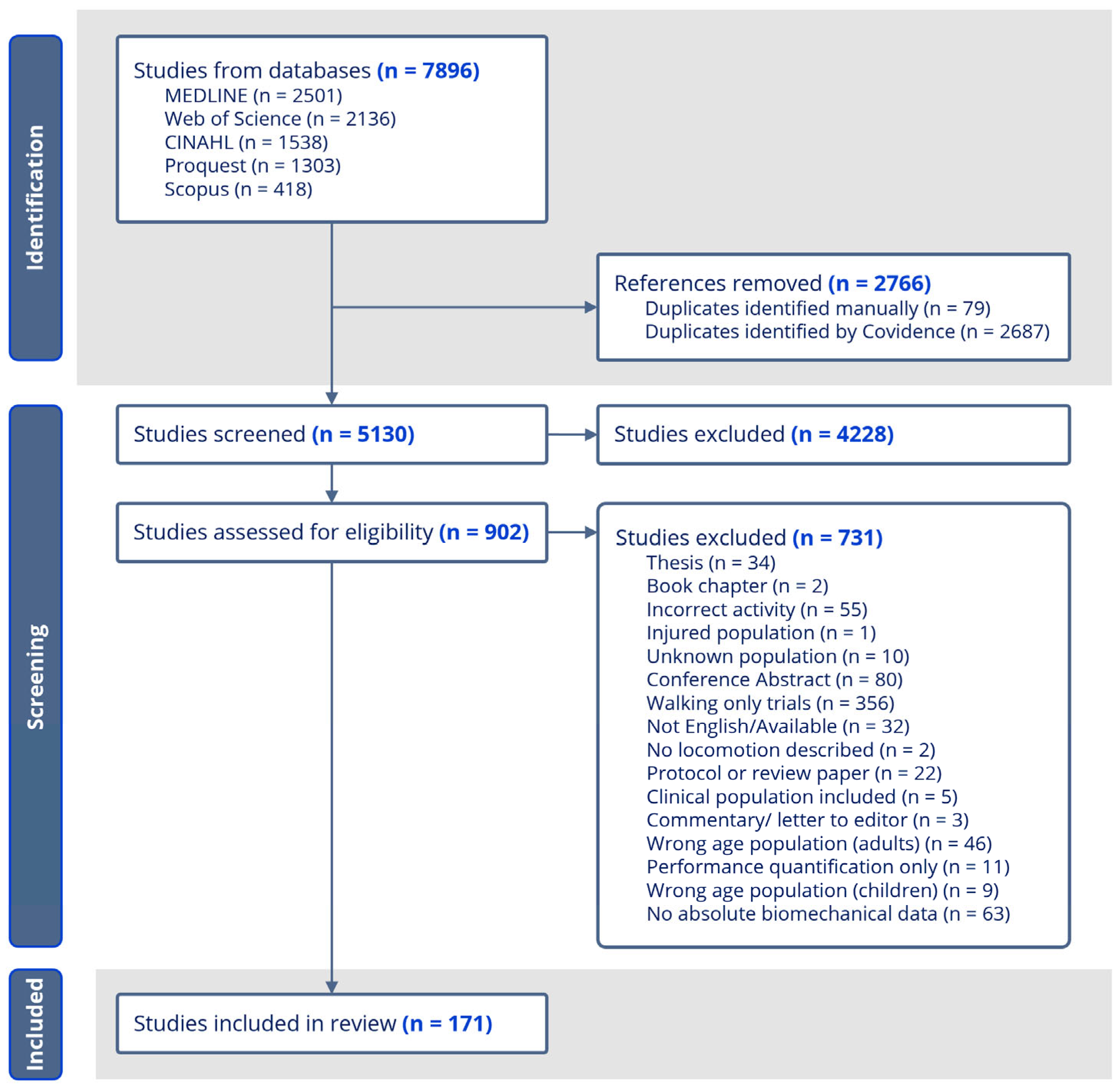
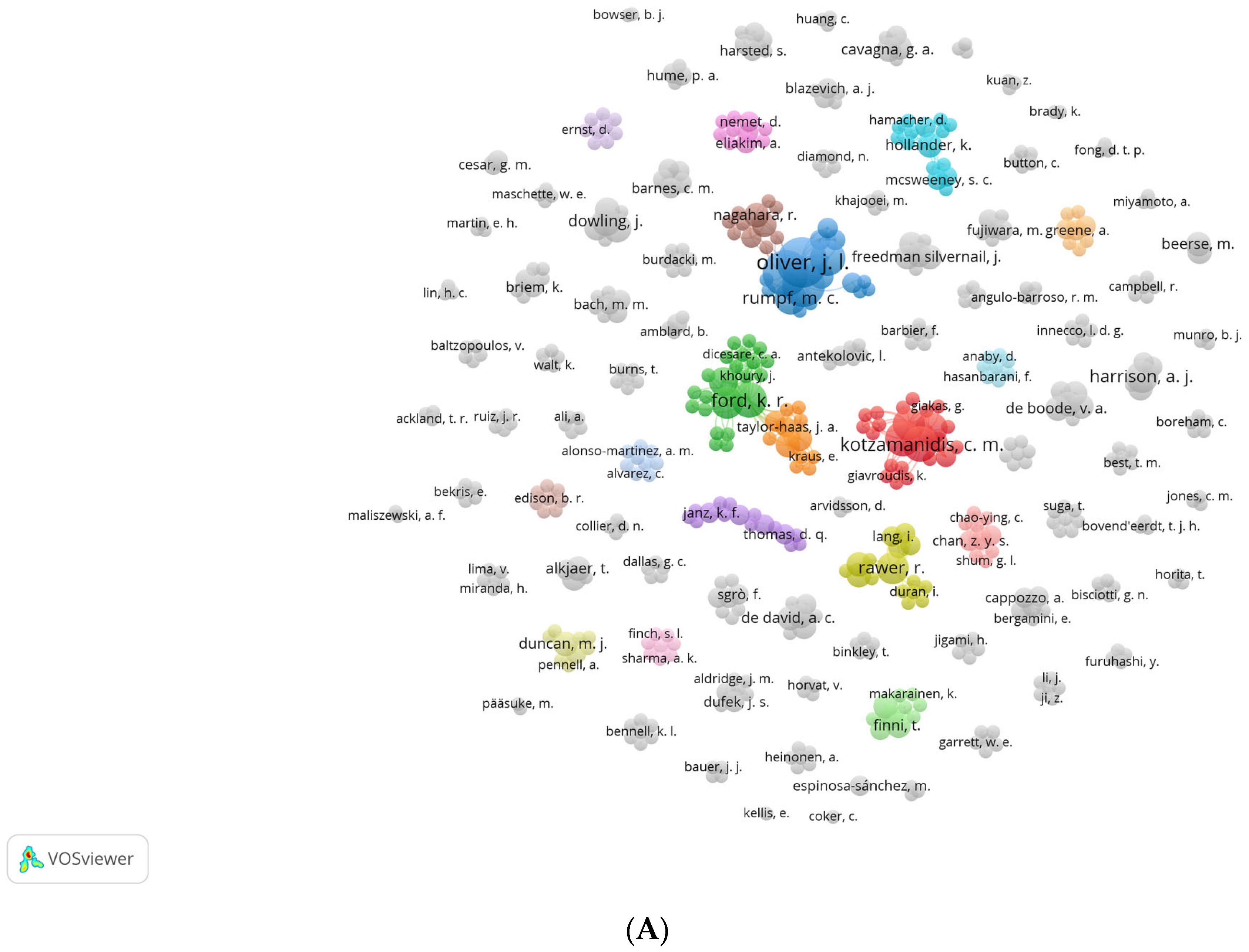
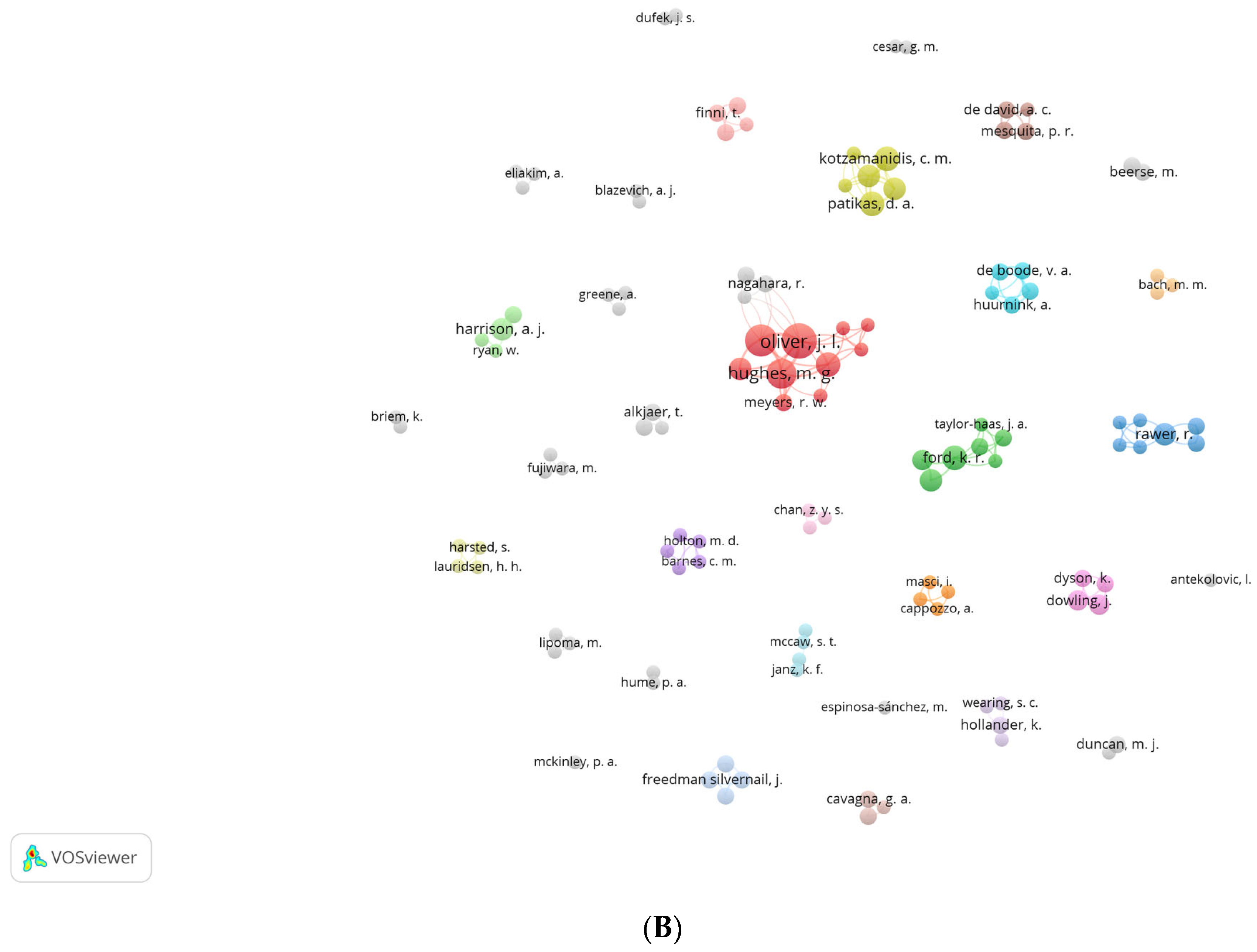
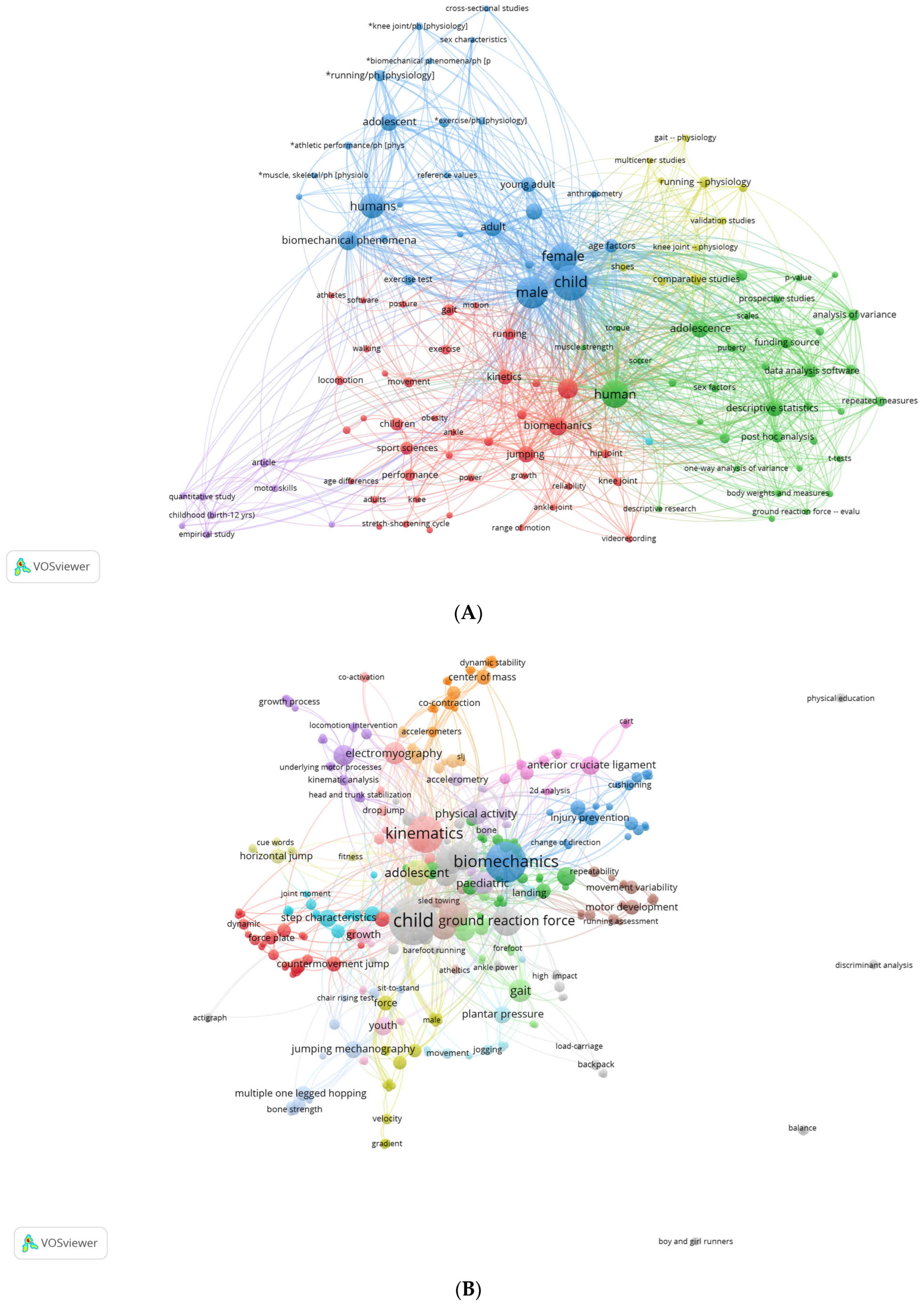
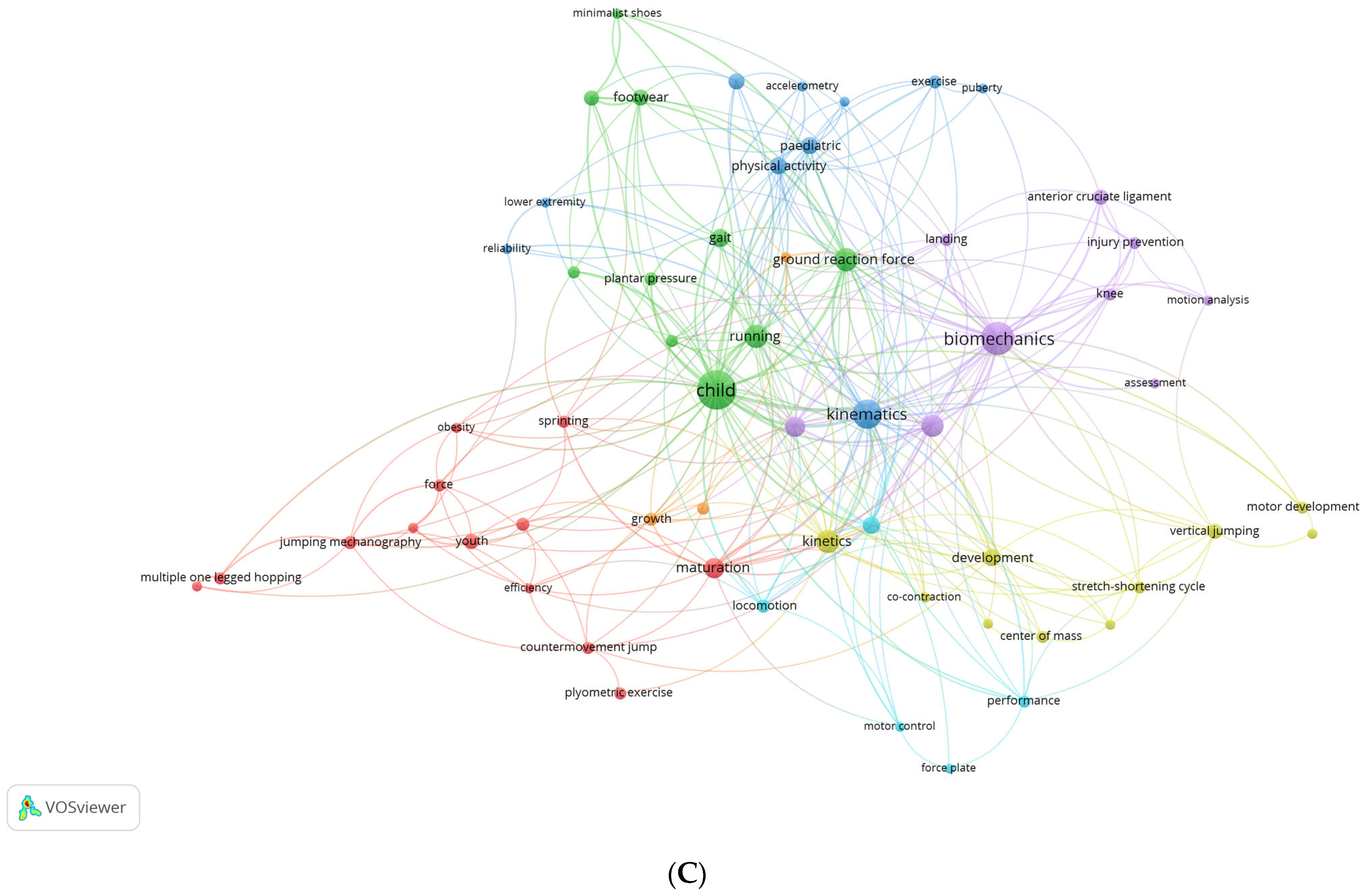



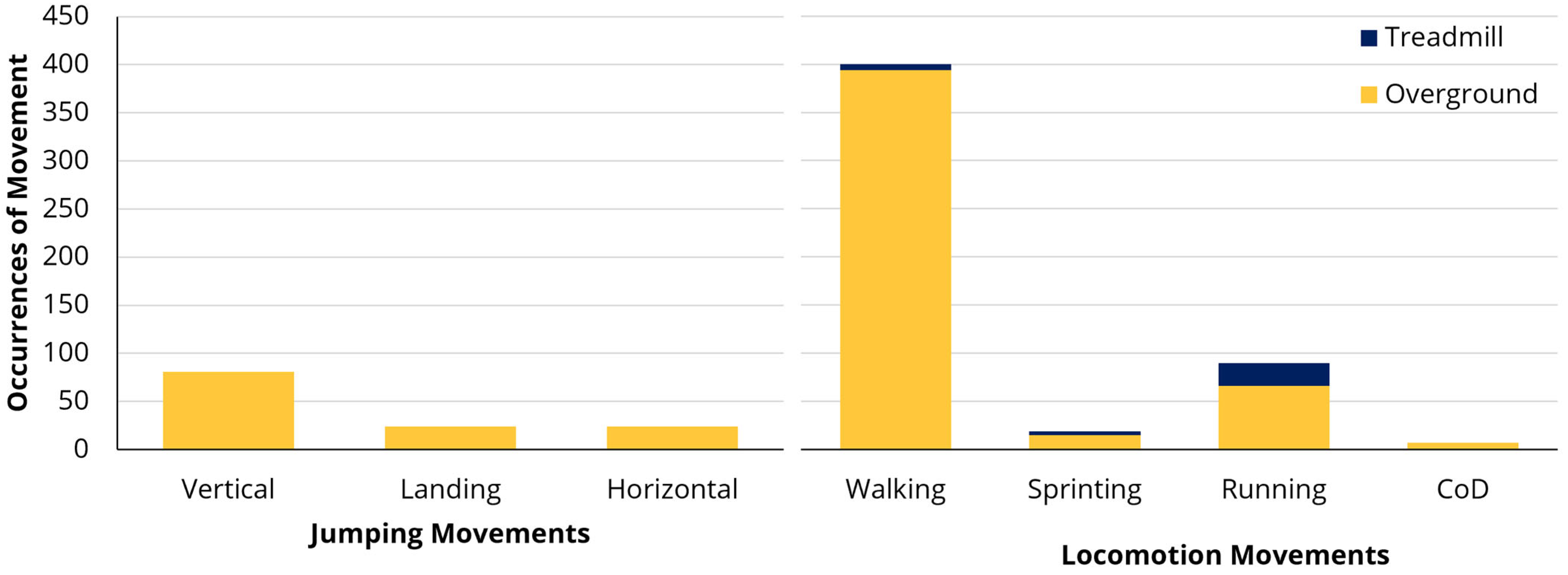
| Funding Body Category | ||||||
|---|---|---|---|---|---|---|
| Charity | Council | Industry | University | Mixed/Multiple | None | |
| Sum | 5 | 29 | 1 | 9 | 29 | 29 |
| % Reported | 4.9% | 28.4% | 1.0% | 8.8% | 28.4% | 28.4% |
| % All | 2.9% | 17.0% | 0.6% | 5.3% | 17.0% | 17.0% |
| Type of Study | Occurrences | Percentage (of 171 Studies) |
|---|---|---|
| Comparison | 127 | 74.3% |
| Descriptive | 5 | 2.9% |
| Intervention | 17 | 9.9% |
| Longitudinal | 10 | 5.8% |
| Methods | 2 | 1.2% |
| Reference values | 2 | 1.2% |
| Relationship | 36 | 21.1% |
| Reliability | 15 | 8.8% |
| Repeatability | 6 | 3.5% |
| Validity | 12 | 7.0% |
| Variability | 5 | 2.9% |
| Data Collection Setting | Occurrences | Percentage (of 171 Studies) | Percentage (of Reported) |
|---|---|---|---|
| Lab | 76 | 44.4% | 67.3% |
| School | 19 | 11.1% | 16.8% |
| Indoor training facility | 9 | 5.3% | 8.0% |
| Hospital | 5 | 2.9% | 4.4% |
| Outdoor field test | 4 | 2.3% | 3.5% |
| Not reported | 58 | 33.9% | - |
| Biomechanical Outcome | Occurrences | Percentage (of 171 Studies) |
|---|---|---|
| EMG | 19 | 11.1% |
| Kinematics | 94 | 55.0% |
| Kinetics | 112 | 65.5% |
| Plantar Pressure | 10 | 5.8% |
| Spatiotemporal | 73 | 42.7% |
| Device Type | Measurement Device | Occurrences | Percentage (of 171 Studies) |
|---|---|---|---|
| Electromyography Electrode | EMG electrode | 19 | 11.1% |
| Textile EMG | 3 | 1.8% | |
| Motion Capture | Marker MoCap (vicon/qualisys) | 57 | 33.3% |
| Video camera | 43 | 25.1% | |
| Markerless MoCap | 4 | 2.3% | |
| Force | Force plate | 96 | 56.1% |
| Dynamometer | 5 | 2.9% | |
| Instrumented treadmill | 12 | 7.0% | |
| Non-motorised force treadmill | 4 | 2.3% | |
| Spatiotemporal | Walkway (GAITrite) | 1 | 0.6% |
| Optojump | 4 | 2.3% | |
| Foot switch | 2 | 1.2% | |
| Contact mat | 2 | 1.2% | |
| Plantar Pressure | Pressure platform (Emed) | 6 | 3.5% |
| Insole pressure | 1 | 0.6% | |
| Inertial | Accelerometer | 13 | 7.6% |
| IMU | 4 | 2.3% | |
| Sonography | Ultrasound | 1 | 0.6% |
Disclaimer/Publisher’s Note: The statements, opinions and data contained in all publications are solely those of the individual author(s) and contributor(s) and not of MDPI and/or the editor(s). MDPI and/or the editor(s) disclaim responsibility for any injury to people or property resulting from any ideas, methods, instructions or products referred to in the content. |
© 2025 by the authors. Licensee MDPI, Basel, Switzerland. This article is an open access article distributed under the terms and conditions of the Creative Commons Attribution (CC BY) license (https://creativecommons.org/licenses/by/4.0/).
Share and Cite
Hammocks, A.; Price, C.; Jones, P.A. Biomechanical Quantification of Children’s Gross Motor Movement: A Systematic Scoping Review. Biomechanics 2025, 5, 28. https://doi.org/10.3390/biomechanics5020028
Hammocks A, Price C, Jones PA. Biomechanical Quantification of Children’s Gross Motor Movement: A Systematic Scoping Review. Biomechanics. 2025; 5(2):28. https://doi.org/10.3390/biomechanics5020028
Chicago/Turabian StyleHammocks, Andrew, Carina Price, and Paul A. Jones. 2025. "Biomechanical Quantification of Children’s Gross Motor Movement: A Systematic Scoping Review" Biomechanics 5, no. 2: 28. https://doi.org/10.3390/biomechanics5020028
APA StyleHammocks, A., Price, C., & Jones, P. A. (2025). Biomechanical Quantification of Children’s Gross Motor Movement: A Systematic Scoping Review. Biomechanics, 5(2), 28. https://doi.org/10.3390/biomechanics5020028







